Head of Enterprise Applications: An Often Untapped Orchestrator for Growth and Scale

Key Insights:
- Many scaleups are seeing the need for a new role to handle daunting internal systems complexity, back-office business systems, integrations, and data.
- Hiring a Head of Enterprise Apps and Architecture role in the organization can help scaleups proactively navigate key security and tech process questions while prioritizing growth and innovation.
- The most common time to hire this function is in the ScaleUp stage — when a company is at $50-$100M annual revenue.
- This role usually reports to a CIO, COO, or CFO.
Boards of directors are seeking digital acceleration from their CxOs and expect enterprise architecture to be orchestrated to enable growth and scale. For ScaleUps already on their digital path, that means transformation of business processes through technology and the deliberate integration of complex digital landscapes. It also means application rationalization to keep operating expenses in check, especially if mergers and acquisitions continue to be part of the growth strategy.
In early-stage companies, many CxOs must also absorb responsibilities for the company’s back-office business technology in addition to their core role. CxOs in these cases can tend to stand up internal business systems in silos while enterprise applications remain poorly integrated with the organization’s IT infrastructure. The repercussions are significant, resulting in low-data quality for internal users to work with, the inability to produce key business KPIs, and ultimately, a poor customer experience. However, there is a solution: The main strategy for dealing with daunting internal systems complexity is to form an enterprise applications and architecture team, responsible for back-office business systems, integrations and data. The head of enterprise applications and architecture thus becomes the master orchestrator of processes and applications for all business units.
Assessing the Need for a Head of Enterprise Apps and Architecture
The need for a master orchestrator was identified in a 2018 survey conducted by threat-assessment company F5. The survey revealed that 38% of the respondents could not name all the applications used by their organization, despite considering 34% of their web applications to be “mission critical.” So how do you determine if your company needs a head of enterprise applications? Below is a simple checklist:
- Unmet technology needs. Does the business have capability needs that aren’t supported by current back-office applications? This can happen as the company matures, when the customer base shifts and departments expand their tooling, both to meet demand and to deliver greater value to consumers.
- Software ownership. Scaleups often struggle to decide whether to buy off-the-shelf software or to build it themselves. In some cases, it can make more sense to purchase while, for others, an in-house solution works better. Left unchecked, these decisions can result in complex system landscapes.
- Architectural vision. Is there a clear internal vision for the company’s business systems architecture? The company should identify which systems add competitive advantage through advanced “best of breed” feature sets and where cost savings can be achieved with mid-market options.
- Gaps and overlaps. Which systems offer necessary features and which are redundant? With off-the-shelf enterprise software there will always be gaps in capability, and some redundancies. The problem goes further than unnecessary spending: if different teams use different software to achieve the same objective, progress can be hampered and KPIs can’t be reconciled. Leaders who are dedicated to managing the life cycle of enterprise applications will be able to identify these gaps and overlaps, and make effective rationalization decisions.
- Software integration. Are the company’s enterprise applications interoperable? The ability of applications like ERP systems to integrate with sales and marketing eliminates redundancies in capability and provides the functionality enterprises need as they scale. Business leaders have made interoperability a critical part of purchasing decisions, especially as technology needs evolve with the business.
- KPIs. Key performance indicators (KPIs) help you understand whether the company’s enterprise systems are delivering required outcomes. If they’re not, then the ScaleUp will likely re-evaluate the organization’s app development and management strategies.
- Projects. Perhaps the strongest signal that the company needs a cohesive application strategy – and leadership – is the failure of systems and data projects to deliver on time and/or to offer the expected business capabilities and KPIs.
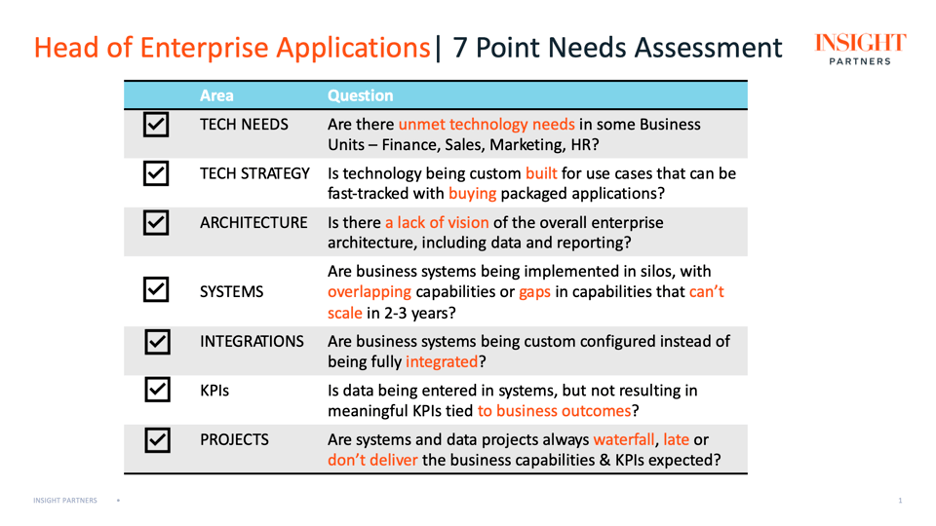
Scope of the Role
A head of enterprise applications and architecture straddles a wide scope of responsibilities covering the range of tech strategy. Responsibilities include the choice of enterprise platforms for the organizations to adopt, as well as its implementation and testing processes. Improving DevOps and predictable agile delivery also fall under their purview. They are bilingual, well-versed in the languages of business (including SLAs and KPIs) and technology. The head of enterprise applications and architecture connects back-office business technology to core revenue-generating product applications.
The enterprise applications team will oversee most major enterprise software systems, including:
- customer relationship management (CRM) systems
- marketing automation platforms (MAP)
- enterprise resource planning (ERP) suites
- human capital management (HCM) tools
- enterprise data systems (EDS)
- overall integration layer
This team does not need to own every business system, of course. Instead, they focus on those tools that require major investment, integrations or that affect business processes like quote-to-cash or hire-to-retire. These are tools that need to be properly integrated and governed if they are to deliver maximum business impact. ScaleUps are finding that a dedicated enterprise applications team is the optimal way to accomplish this.
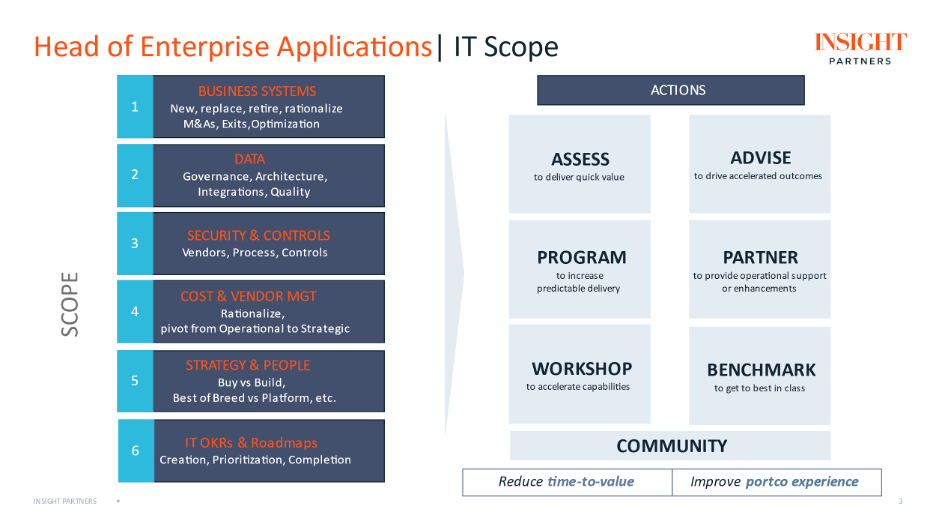
As mentioned earlier, a key function of the head of enterprise applications is to navigate the build versus buy decision. While engineering is almost entirely a “build” team (they build the product the company sells), enterprise software leaders often lean towards “buy” in order to optimize cost and deliver the best value. However, some companies do give enterprise applications teams the freedom to build internal tools. As a result, enterprise applications leaders are often well-versed in the intricacies of building, integrating, and deploying software and DevOps.
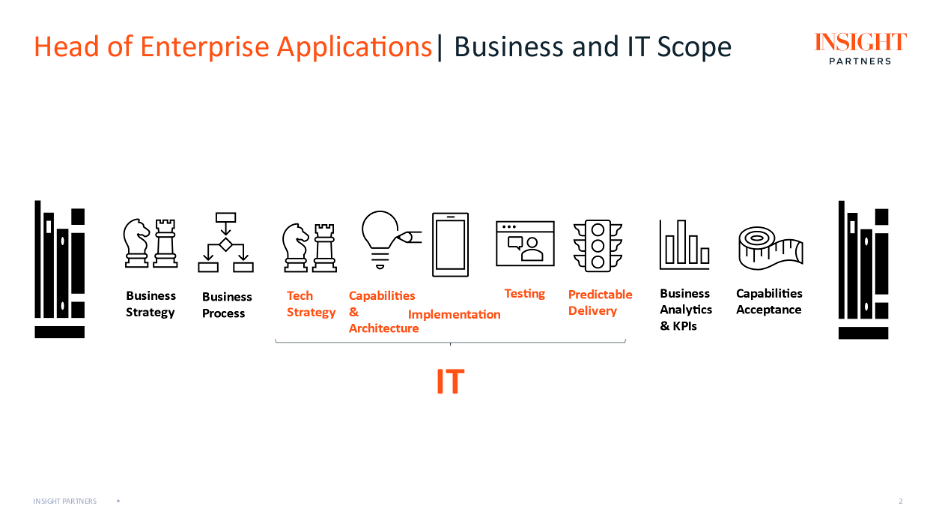
Timing Based on Growth and Cash Flow
Exactly when a business will need a dedicated enterprise apps team is difficult to predict. Innovation and scale are significant drivers — innovating and investing in digital transformation are top priorities in today’s tech landscape. For most companies, this point arrives as the company transitions from the growth to the ScaleUp phase, typically with between $50 million and $110 million in annual revenue. In later stages, we recommend a CIO, who reports directly to the CEO.
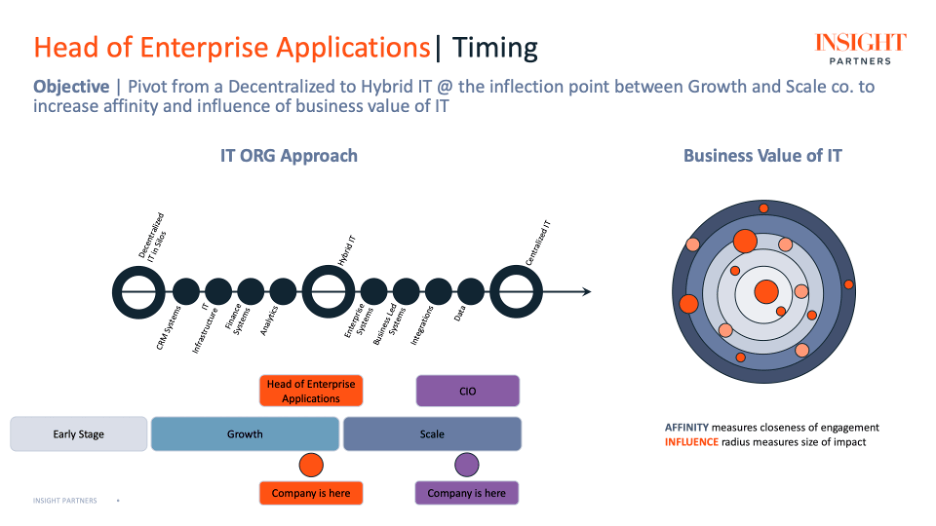
Not all companies manage this transition successfully. Some continue early-stage practices of bringing in consultants to improve processes, but this is a stop-gap measure at best and, when consultants depart, their expertise goes with them. By contrast, organizations with a unified head of enterprise apps and architecture can avoid this churn. This role can serve as a focal point for specific knowledge within the company about business capabilities and managing enterprise applications.
From a cash-flow perspective, companies that struggle to fund and prioritize this role, often have to divest operationally first before they can re-invest strategically, or ask business CxOs to wear a more technical hat.
Reporting Structure
Many companies that create an enterprise applications team assign it to the CIO’s area of responsibility. In the absence of a CIO, the head of enterprise applications typically reports to the COO or CFO.
The CTO is the least-preferred executive to oversee this critical function. That’s because CTOs need to focus on innovating and driving revenue by building out the core product and finding the right product-market fit.
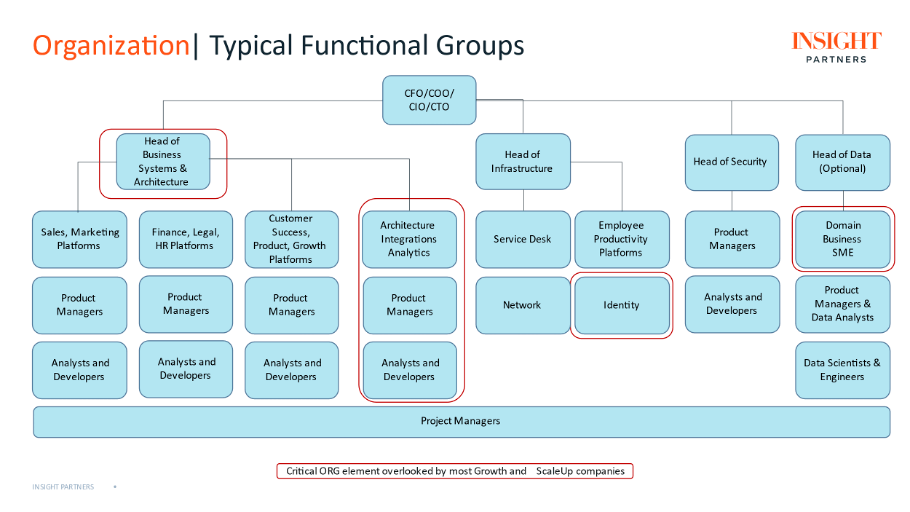
How does one find qualified IT leaders to occupy this position? The truth is, it can be challenging. Since this is a technical role, the best candidates will have a technical background. IT operations candidates that have only managed networks, desktops or help desks are not good candidates because they lack the business skills needed to speak to sales, marketing and finance executives.
Enterprise applications candidates will have deep experience building software integrations and navigating the complicated web of interoperable enterprise systems. They will also have experience with global implementations, doing configuration or code reviews, and building out proofs of concept for customer relationship management platforms, marketing operations, finance, and accounting systems. Because of the complex nature of the role and the need for outstanding technical, business and interpersonal skills, you can expect to spend at least three months searching for a qualified head of enterprise applications and architecture.
Aligning Business and IT Goals
The ability to unite the company’s business goals with the IT department’s priorities is a unique and critical skill for a head of enterprise architecture to have. That’s because enterprise apps teams serve the entire organization.
That makes this role strategic instead of operational — rather than just managing the status quo, a good head of enterprise architecture will be able to identify areas of business capabilities improvements and drive long-term business value. These skills are part of a wider trend in IT and business leadership – a radical shift from just “keeping the lights on” to planning and driving growth.
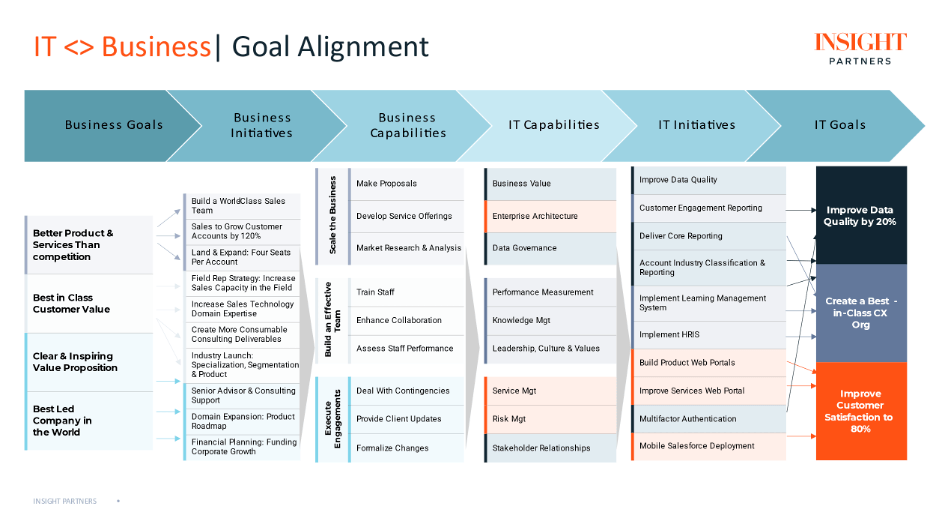
The process includes the ability to get stakeholder buy-in, especially for large-scale changes such as introducing new ERP or CRM systems, or a shift to cloud-based architecture. It also requires a solid understanding of the rest of the organization’s pain points. The best candidates for this role have the ability to identify and implement solutions that align with the organization’s business priorities.
Security Counts
Another critical skill set is a thorough knowledge of application security. As the number of applications a company uses increases, so does its security overhead and the risk of a breach. The diversity of applications also makes the task of securing them more complex.
Furthermore, since many of these systems are used by non-technical staff (such as sales, marketing or HR) there’s an increased burden on the enterprise apps team to educate staff on proper security, release management, and control procedures. ERP systems are notorious for vulnerabilities because they are large, complex applications often used by multiple teams. Their size and flexibility mean that different departments often configure them with customizations or plugins.
However, integrating these systems is not the only concern. Most modern enterprise software is based on cloud technology, which makes IT architecture leaders with strong cloud deployment and cloud security awareness an asset. The nature of cloud technology means there is some overlap between the IT-focused enterprise apps role and the infrastructure engineering role responsible for providing DevOps support to core engineering. While both enterprise app teams and infrastructure teams might work on cloud-deployed technology, they are very often different cloud environments to manage. Enterprise apps are usually deployed to dedicated, vendor-owned (and made) cloud platforms. Infrastructure engineers, by contrast, work much closer to the code on platforms that deploy the company’s core product.









